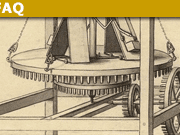A Brachistochrone Subway Is Not a Cost-effective Idea
It is apparent that a subway tunnel could be built without the need for supplied energy like electricity, assuming zero friction everywhere. The tunnel would go underground, level off, and then climb back up, all just by exchanging potential and kinetic energy.
However, the question arises: What should be the shape of the tunnel for minimum travel time between two stations separated by a distance d? This question is the Brachistochrone (B.) problem and was first formulated by Bernoulli in the very late 17th century as ‘what path gives the shortest time for an object to slide along a smooth curve from point A to point B under the influence of gravity?’. Bernoulli himself, his brother, Leibnitz, Newton, and two others submitted solutions, which was the cycloid. (The last entry was submitted anonymously but somehow everyone recognized it as belonging to Newton). Later, Euler and Lagrange beefed up and generalized the theory. So some very heavy hitters were involved. For more historical info see
http://en.wikipedia.org/wiki/Brachistochrone_curve
In the case of a subway, we want to minimize the time to go from one station to the next. So we apply the B. problem to the first half of the journey, from 1st station to tunnel bottom, then multiply by 2. The only initial constant is d, the above-ground distance from the station to station.
So let us set up an x-y coordinate system with x the ground and y the depth below ground. The train starts at x=y=0 and ends up at x = d, y=0. The max. depth is h, to be determined. I define h>0.
The Brachistochrone problem is a special case of the problem in variational calculus which extremalizes (minimizes or maximizes) a definite integral of the form
In fact, the integral to be minimized is obviously
where is the length of the slide and v the speed along the slide. But ds2 = dx2 + dy2 and v is determined from v2/2 = gy so we wind up with
f = {[1 + (dy/dx)2]/2gy}1/2.
The corresponding Euler DE is
y’ ∂f/∂y’ – f = c with y’ = dy/dx
where in this case c can be computed to be c = √(π/2gd).
I am omitting a lot of math here but can provide leads if wished.
I got curious as to the tunnel’s lowest point required for minimum station-to-station transit time. I calculated that the max. depth would have to be h=d/π and the corresponding transit time would be T = √(2πd/g).
That would be a depth of h=0.32 miles or 1681 ft. (488 m.) for a d=1 mile (1600 m.) inter-station, above-ground distance, with T = 32.0 s. Pretty deep and steep! Maximum speed at the bottom would be around 225 mph – moving right along! Above-ground speed would average 112 mph.
Also, of course, air resistance and rail friction would reduce speeds and require some externally furnished energy. But, I would think, to a modest extent.
If a lesser tunnel depth were desired, we could for example halve the above depth to 800 ft (244 m.). To retain the cycloidal tunnel shape, the inter-station distance per cycloid (spatial) period would then also be halved. So, to cover 1 mi., the train would descend to 800 ft., pop up at d = 1/2 mi., then repeat the trajectory to finally cover the full above-ground mile. Transit time goes as the square root of above-ground distance per cycloid period so the new 1-mi. time would increase to T=45.2 s.
All this begs another question: suppose we wanted to dig a tunnel to a depth of h=800 ft. (244 m.) without popping up halfway in-between? (This idea would preclude a brachistochrone.) I postulated an arc of a circle spanning x=0 and x=d, with the bottom of the arc 244 m. below the x-axis. This circle turned out to be centered at (d/2,R-h), and $$R = radius = (d/2)^2/8h + h/2$$. Unfortunately, I ran into some very heavy math, including the “elliptical integral of the first kind with parameter m = k^2”, whatever that is, so I couldn’t come up with a closed-form for the corresponding transit time.
However, I was able to run numerical simulations with Excel. Here are a few of the results:
d = 1 mile, depth = 244 m. : T = 38.7 s. This beats the two-cycloid version of T = 45.2 s.
d = 1 mile, h = 100 m. : T = 57.2 s.
d = 1 mile, h = 50 m. : T = 80.0 s.
d = 1 mile, h = 25 m. : T = 112.7 s.
d = 1 mile, h = 10 m. : T = 177.3 s.
From this we can conclude that a low depth does not necessarily impose an unacceptably low transit time and that a brachistochrone subway is not a cost-effective idea!
AB Engineering and Applied Physics
MSEE
Aerospace electronics career
Used to hike; classical music, esp. contemporary; Agatha Christie mysteries.








Interesting topic.
[QUOTE=”mfb, post: 5108573, member: 405866″]Where is the point in the circle arcs?
You know the fastest way to get from A to B in general – let the deepest point of the brachistrochrone be at a depth of h. What is the ideal shape if you want to take a longer distance, but with depth limited to h? Well, just add a straight section in between the brachistrochrone halves. It will run at the maximal possible speed, and you already know the first and last part cannot be faster.
For the 1600m distance, you need 22.6 s for the curved sections, and 12 seconds for 800m at 66m/s, for a total of 34.6 seconds.[/QUOTE]
Good observation. Thanks.
Where is the point in the circle arcs?
You know the fastest way to get from A to B in general – let the deepest point of the brachistrochrone be at a depth of h. What is the ideal shape if you want to take a longer distance, but with depth limited to h? Well, just add a straight section in between the brachistrochrone halves. It will run at the maximal possible speed, and you already know the first and last part cannot be faster.
For the 1600m distance, you need 22.6 s for the curved sections, and 12 seconds for 800m at 66m/s, for a total of 34.6 seconds.
Following mfb's observation, the title of my blog should be changed to "Modified Brachistochrone Subway!". mfb has come up with the ideal solution and it resurrects the viability of the Brachistochrone in subway engineering!
Very unique entry!
Well this was worth reading i learned something interesting today so thanks for writing this.